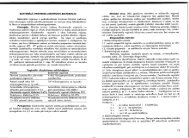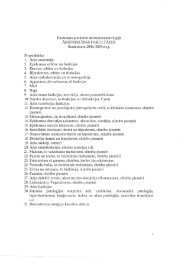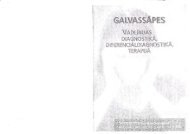PHYSICS
n - susliks.lv
n - susliks.lv
- No tags were found...
Create successful ePaper yourself
Turn your PDF publications into a flip-book with our unique Google optimized e-Paper software.
a<br />
E E +<br />
a :mmr<br />
b<br />
Fig. 15.1. Schematic diagram<br />
of the electric field: a - for two Fig. 15.2. Uniform (a) and<br />
equal and opposite charges; nonuniform (b) electric field<br />
b - for point charges<br />
are related to the electric field in any region of space in the<br />
following manner:<br />
1. The electric field vector (E) is tangent to the electric field<br />
line at each point;<br />
2. The number of lines per unit area through a surface<br />
perpendicular to the lines is proportional to the strength of the<br />
electric field (or the magnitude of the charge) in that region.<br />
3. The lines must begin on positive charges and terminate on<br />
negative charges, or at infinity in the case of an excess of charge;<br />
4. No two field lines can cross.<br />
An important field for consideration is the uniform electric<br />
field (fig. 15.2, a); a field that has the same magnitude and direction<br />
at all points. In the opposite situation, the field is non-unifornm<br />
(fig. 15.2, b).<br />
15.2.4. Electric Potential<br />
Instead of dealing directly with the potential energy of a<br />
charged particle, it is useful to introduce the more general concept<br />
of energy per unit charge.<br />
Suppose a test charge (qo) moves from A to B under the influence<br />
of a field (E ). The work (dA) done by the electric force (qE) on<br />
the test charge for an infinitesimal displacement (di) is given by:<br />
114<br />
dA = F .dx = qoE .di: (15.4)<br />
By definition, the work done by a conservative force equals the<br />
negative of the change in potential energy (dU); therefore:<br />
dA = - dU = - qaE ·di (15.5)<br />
A force is conservative if the work done by the force acting on<br />
a particle moving between two points is independent of the path<br />
the particle takes between the points.<br />
For a finite displacement of the test charge between points<br />
A and B, the change in the potential energy is given by:<br />
-%I B U =U B<br />
-U A = j;·dX<br />
(15.6)<br />
A<br />
where U and U<br />
B A<br />
are the initial and final potential energies,<br />
respectively.<br />
The potential difference (,1cp) between points A and B is defined<br />
as the change in potential energy divided by the test charge (qo):<br />
U B U A<br />
ticp = cp E- dx<br />
B - CPA = - - - = -I . x (15.7)<br />
qo qo A<br />
The quantity which equals the energy per unit charge [rp = ~)<br />
is called the electric potential (U).<br />
qo<br />
The unit of potential is the Joule per Coulomb, which is equal<br />
to a volt (1 V = 1 J/c)·<br />
15.2.5. Obtaining E from the Electric Potential<br />
The electric field (E) and the potential (U) are related by<br />
Equation (15.7). To calculate the electric field if the electric potential<br />
is known in a certain region, apply Equation (15.7) when<br />
there is a uniform electric field:<br />
B B B<br />
L1 qJ = - IE. dx = - I E cos OOds = - IEds (15.8)<br />
A A • A<br />
Since E is constant, it can be removed from the integral sign,<br />
giving:<br />
B<br />
115






